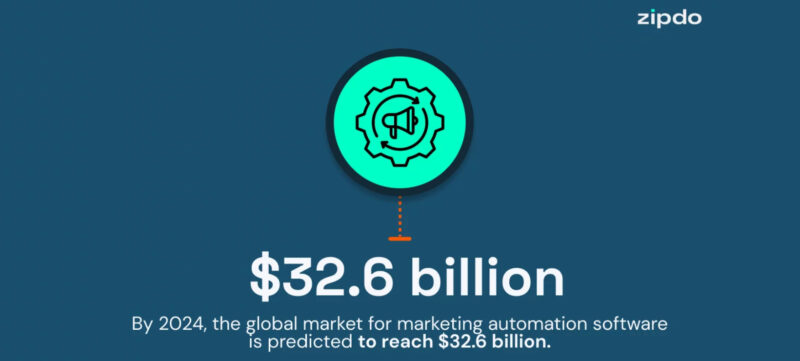
Table of Contents
[caption id="attachment_4265" align="aligncenter" width="800"] Source: Zipdo[/caption]
Source: Zipdo[/caption]
Understanding MarTech
Before we delve into the trends, let's establish a clear understanding of what MarTech is. MarTech refers to the blend of marketing and technology. Any software or tool that marketers use to streamline, automate, and measure their marketing activities falls under this umbrella. This can include anything from email marketing platforms, customer relationship management (CRM) systems, analytics tools, social media management, and more.Since various tools are needed to tackle different aspects of marketing, businesses will often integrate multiple MarTech solutions within their operations. Carefully chosen and harmonized to work seamlessly together, this is referred to as a MarTech stack. Check out this video to learn more about MarTech stacks:
[embed]https://www.youtube.com/watch?v=PFzi8jGM92k[/embed]
As digital technology continues to advance at a rapid pace, so does MarTech. It's crucial for businesses to stay on top of these changes to maintain a competitive edge and deliver superior customer experiences. By understanding the latest MarTech trends, businesses can make strategic decisions, optimize their MarTech stack, and drive growth. Therefore, keeping up with MarTech trends isn't just beneficial—it's essential.
Related Article: The 12 Most Useful AI Tools for Game Developers in 2024
Artificial Intelligence (AI) and Machine Learning (ML)

The Role of AI in Personalization and Automation
Beyond being a buzzword, AI's profound potential is increasingly being harnessed to redefine how marketers engage with their audience. One notable strength lies in its ability to process and analyze colossal datasets, providing marketers with deep insights into customer behaviors and preferences. Leveraging this wealth of information, AI empowers marketers to curate highly personalized content, targeted offers, and tailored recommendations, thus enhancing the overall customer experience.A significant advantage of AI in marketing is its capacity to automate mundane and repetitive tasks. This automation not only expedites processes but also liberates marketing professionals from routine operations, allowing them to redirect their focus towards more strategic initiatives and creative campaigns.
How ML is Transforming Data Analysis
As a subset of AI, ML introduces a big change by automating and refining the data analysis process. Unlike manual analysis, ML algorithms possess the capability to navigate and sift through enormous datasets with exceptional speed and precision. This proficiency enables them to discern intricate patterns and trends that might elude human observation, providing marketers with a nuanced understanding of customer behaviors and market dynamics.One of the benefits of integrating ML into the MarTech stack is its impact on segmentation, targeting, and predictive analytics. ML algorithms can dynamically segment audiences based on nuanced criteria, allowing for more refined and accurate targeting strategies. By leveraging historical data, ML facilitates predictive analytics, enabling marketers to anticipate future trends, customer preferences, and potential outcomes with a higher degree of accuracy. This foresight empowers marketers to optimize their strategies proactively, enhancing overall marketing effectiveness.
Moreover, the iterative nature of ML allows these algorithms to continuously learn and adapt in response to changing market dynamics. This adaptability is particularly valuable in an environment where consumer behaviors and preferences are constantly evolving.
Related Article: The Best 5 AI Tools To Boost Your Academic Research in 2024
Conversational Marketing and Chatbots

Enhancing Customer Engagement Through Real-Time Conversations
Conversational marketing represents a paradigm shift in customer engagement by fostering real-time, two-way communication. Unlike traditional one-way marketing funnels, conversational marketing creates a dynamic dialogue, enabling businesses to forge more personalized and meaningful interactions with their audience.The Evolution and Impact of Chatbots in Marketing
Chatbots play a pivotal role in the evolution of conversational marketing, addressing customer inquiries around the clock and delivering personalized product recommendations in real-time. Moreover, these intelligent bots extend their capabilities to assist with transactions, providing a seamless and efficient avenue for customers to engage with a brand. The integration of chatbots into the marketing strategy not only improves operational efficiency but also enriches the overall customer journey by offering instant, tailored solutions.As AI capabilities progress, chatbots have become more sophisticated. Today's chatbots are adept at understanding natural language, learning from user interactions, and delivering responses that closely emulate human communication. This increased sophistication positions chatbots as invaluable tools in modern marketing, contributing significantly to elevated customer satisfaction levels and driving higher conversion rates.
Voice Search Optimization

Related Article: Top 7 Healthcare Technologies for Mental Wellness in 2024
The Rising Importance of Voice Search in SEO Strategies
Voice search is no longer just a novelty—it's a rising trend that marketers need to take seriously (Digital Technology Service On Demand, 2023). As more consumers adopt voice-activated devices like Amazon Echo and Google Home, the way people search for information is changing. This means SEO strategies must evolve too. Marketers need to understand how voice queries differ from typed searches and optimize their content accordingly.Adapting Content for Voice-Activated Searches
To effectively cater to this shift, marketers are encouraged to prioritize the incorporation of long-tail keywords and embrace a more natural language tone in their content creation. Long-tail keywords align with the specificity of voice queries, enhancing the chances of content being surfaced in response to intricate, context-rich inquiries.Furthermore, Frequently Asked Questions (FAQs) emerge as a strategic asset in the arsenal of content optimization for voice searches. Given that many voice queries inherently take the form of questions, structuring content around comprehensive FAQs not only addresses user queries directly but also aligns with the conversational nature of voice interactions.
Augmented Reality (AR) in Marketing

Immersive Brand Experiences Through AR
AR is another technology that's making waves in marketing (Digital Technology Service On Demand, 2023). AR overlays digital information onto the real world, creating immersive experiences that can bring products to life. For marketers, this opens up exciting new ways to engage customers. Whether it's virtually trying on clothes or previewing furniture in your home, AR offers a unique, interactive experience that can elevate your brand.Related Article: Top 10 AI Assistants for Teachers in 2024
Case Studies of AR in Product Visualization and Trials
Many brands are already leveraging AR to great effect. Prominent examples, such as IKEA's innovative AR app, empower customers to visualize furniture in their homes virtually before making a purchase. This application not only bridges the gap between online browsing and the in-store experience but also provides consumers with a tangible understanding of how products fit within their living spaces.Sephora's Virtual Artist represents another compelling instance of AR integration. This tool allows users to virtually try on various makeup looks, offering a personalized and interactive experience. By enabling customers to experiment with different products in a virtual environment, Sephora enhances the exploration and decision-making process, fostering a more informed and satisfying shopping journey.
These implementations underscore AR's capacity to go beyond entertainment and serve as a practical tool for consumers. By integrating AR into the shopping process, brands not only differentiate themselves but also address the evolving expectations of tech-savvy consumers. The ability to visualize products in real-world contexts or virtually try them before purchase significantly influences consumer confidence, leading to more informed and confident buying decisions.
Blockchain for Transparency and Security

Blockchain’s Potential to Revolutionize Consumer Trust
Blockchain isn't just for cryptocurrencies—it also has significant implications for marketing. At its core, blockchain is about transparency and security. It can provide a decentralized record of transactions that's transparent and immutable. For consumers increasingly concerned about privacy and trust, this could be a game-changer. Brands that leverage blockchain could gain a competitive edge by building greater trust with their customers.Applications of Blockchain in Ad Fraud Prevention
Blockchain also holds promise for combating ad fraud—one of the biggest challenges in digital marketing. By leveraging a tamper-proof distributed ledger, blockchain ensures secure and immutable record-keeping of ad transactions, reducing the risk of fraud. Smart contracts automate verification processes, executing predefined conditions and minimizing fraudulent activities. Blockchain enhances identity verification, prevents ad stacking and domain spoofing, and brings transparency to the advertising supply chain.Moreover, real-time monitoring helps detect anomalies, while decentralized ad verification and token-based incentives promote honest behavior. The technology's immutability provides an auditable trail for post-event analysis, contributing to the creation of a trustworthy and efficient digital advertising environment. As such, blockchain can help marketers verify that their ads are being delivered to real people, not bots. This could lead to more efficient ad spending and improved return on investment (ROI).
Related Article: Top 11 Emerging EdTech Companies of 2024
Privacy-Focused Marketing in a Cookieless World

Shifts in Data Collection and Targeting Methods
In light of growing privacy concerns and changes to data regulations, marketers are having to rethink their data collection and targeting methods (Digital Technology Service On Demand, 2023). With third-party cookies on the way out, marketers will need to prioritize first-party data and find new ways to deliver personalized experiences without compromising privacy.Preparing for Changes in Privacy Regulations
As privacy regulations continue to evolve, businesses must stay informed and prepared. This means understanding the implications of regulations like the General Data Protection Regulation (GDPR) and California Consumer Privacy Act (CCPA), and ensuring your marketing practices comply. MarTech tools will continue to play a pivotal role in this. For example, Consent Management Platforms (CMPs) facilitate the transparent management of user consents and preferences, ensuring adherence to the aforementioned regulations.MarTech tools also support sophisticated audience segmentation, enabling businesses to target marketing efforts responsibly and prevent privacy violations. Through features like data anonymization, encryption, and AI-powered compliance audits, MarTech solutions can help safeguard sensitive customer information and identify potential privacy issues. Additionally, these platforms provide dynamic consent management and cross-channel data governance, allowing organizations to adapt swiftly to changes in privacy standards.
The Growth of Video Marketing

Related Article: Top 5 Innovative Sustainable Technology Trends in 2024
The Dominance of Video Content on Social Platforms
Video content has become the dominant form of media on social platforms (Digital Technology Service On Demand, 2023). Whether it's short-form videos on TikTok, live streams on Instagram, or engaging content on YouTube, video is where the attention is. In fact, studies have shown that consumers are more likely to engage with video content than any other type of content. This presents a huge opportunity for marketers to connect with their audience in a compelling and memorable way.Best Practices for Integrating Video into Your Marketing Strategy
Integrating video into your marketing strategy requires careful planning and execution, with numerous factors to consider. First and foremost, it's crucial to define clear objectives and target demographics, ensuring that video content resonates with the intended audience. Crafting engaging and concise videos is paramount, as attention spans are limited.Optimal distribution across various platforms, including social media, websites, and email campaigns, maximizes reach. Implementing strong storytelling techniques and incorporating brand identity consistently across videos fosters brand recognition and loyalty. Prioritizing mobile optimization is essential, given the prevalence of mobile video consumption. Regularly measuring and analyzing video performance metrics allows for continuous improvement, ensuring that the video content remains relevant and effective within the broader marketing strategy.
Furthermore, the rise of interactive video formats and shoppable videos offers even more possibilities for driving engagement and conversions. Understanding these best practices can help you leverage the power of video to achieve your marketing goals.
Concluding Remarks
As we look to 2024, it's clear that the MarTech landscape is rapidly evolving. From AI and ML to conversational marketing, voice search, AR, blockchain, privacy-focused marketing, and video content, there are numerous trends shaping the future of marketing.
[caption id="attachment_4273" align="aligncenter" width="800"] Source: Zipdo[/caption]
Source: Zipdo[/caption]
Embracing innovation in marketing isn't just about staying relevant—it's about unlocking new opportunities for growth and differentiation. By staying abreast of the latest MarTech trends, businesses can position themselves as industry leaders and build stronger connections with their audience. As we move into the new year, let's embrace the possibilities that these trends offer.
References
Digital Technology Service On Demand. (2023). Top 7 Digital Marketing Trends in 2024 for Canada. Medium. https://medium.com/@digital-technology-service/top-7-digital-marketing-trends-in-2024-for-canada-507528644e2eNavarro, J. G. (2023). Global Number of MarTech Solutions 2011-2023. Statista. https://www.statista.com/statistics/1131436/number-martech-solutions/